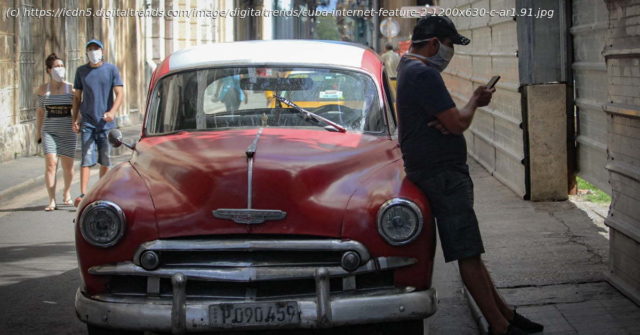Internet coverage has expanded in Cuba, giving more people access and inadvertently flooding the country with a sudden glut of digital culture.
Up until a few years ago, the only way most Cubans could use the internet was to visit a public Wi-Fi hot spot, typically a park or plaza, and connect to the internet using scratch-off cards sold by the hour. These outdoor Wi-Fi hot spots were few and far between, and they provided no protection from the scorching sun or torrential Caribbean downpours. And the reliability of the connection was spotty at best. Cubans didn’t spend their days glued to digital screens, posting carefully curated versions of their lives online. They didn’t experience a near-constant state of FOMO (fear of missing out) if they felt their own lives didn’t measure up to what was showing up in their social media feeds. They met with friends to converse in plazas. They played baseball in the park, soccer in the street, and dominoes on the sidewalk. They held spirited debates in cafes, restaurants, and living rooms. They worked to establish and build a growing number of independently run private businesses popping up across the country. But since then, internet coverage has expanded through mobile providers, giving more and more people access and flooding the country with a sudden glut of digital culture. Those in Cuba say the cultural shift has been dramatic. Cuban President Miguel Díaz-Canél indicated in 2015 that the country would work to make the internet “available, accessible, and affordable for everyone.” At the time, cellular phones were relatively rare, mobile data plans were nonexistent, and only a lucky few individuals had (very slow) dial-up internet at home. While there is certainly room for improvement, the internet has grown more in the past 18 months than it had in the previous decade and the vast majority of Cubans that Digital Trends spoke with were pleased with the progress. Not unlike in the United States and other developed nations, access begins first in large cities but struggles to reach remote areas. Cuba now boasts 1,072 public Wi-Fi hot spots that serve as a vital resource to connect its people with the outside world. However, fewer and fewer people are using them as their primary means of connection. Since December 2018, Cubans have been able to purchase phone-based data plans, allowing them to connect anywhere there is a signal. Between 2015 and 2019, hourly Wi-Fi connectivity rates dropped from $4.50 an hour to $1 an hour. In a country where the average salary hovers around $25 a month, such a significant price drop dramatically increases the number of people who can afford to access the internet. According to Cuban news site 14ymedio, as of January, 2019, 1.






